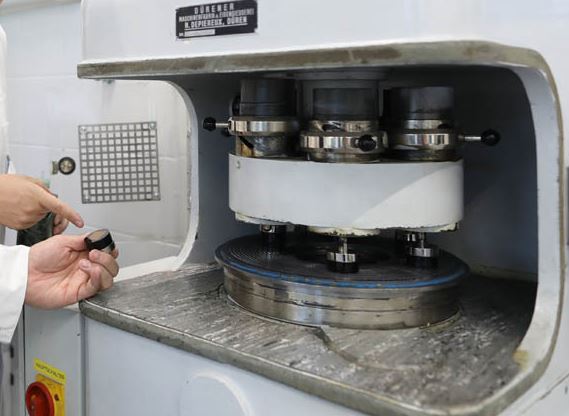Mineralogy – A Crucial Knowledge for Project ReSoURCE

Mineralogical investigation is one of the central tools in our project. It is used for characterization of unused refractory materials on the one hand and, on the other hand, for determination of the cause of wear of used bricks sent back from the customer. In order to be able to adapt the sorting process for the recycling material in the best possible way mineralogical investigations are carried out on the test material. While chemical analyses show changes in the bulk composition of the products in total, it is possible to get more detailed information with the help of microscopic examinations. Here we learn about the type of supplied extrinsic components, corrosion mechanisms and the type of reaction products formed. These findings help setting up the ideal treatment for used bricks in order to use recycling material adequately and in an optimised way.
Prior to any mineralogical investigation the respective brick sample has to be cut dry. On the outer brick surface, it is not possible to determine for example infiltration horizons of supplied components, such as alkali salts. Upon cut section the position for sample taking and the number of samples needed is defined. Sections of size 20mmx20mm are cut from the sample. These sections are then impregnated by a preparation resin in order to be able to polish the samples on the polishing machines.
Usually, a mineralogical investigation starts with light microscopy, using incident light. Especially for used products the examination then continues with scanning electron microscopy combined with energy-dispersive X-ray spectrometry. In that way it is possible to determine the exact composition of every single mineralogical phase present in a sample.

Fig 1 shows the appearance of the microstructure of one of the investigated bricks at the chemically unchanged cold brick end. The black areas represent the original pore space of the brick, which is usually around 16-17%.

Fig. 2 shows an image from a brick zone which was affected by chemo-thermal load. The supply of extrinsic components, alkali salts in that particular case, resulted in a pore filling densification of the microstructure.
The darkest reflecting phase in the picture is the brick’s inherent periclase (1) of the magnesia component. The area in between is bright reflecting potassium chloride (2), which stems from the alternative fuels used for kiln firing, but also from raw materials used for the clinker production. Another major phase in this area of the brick is so-called Calcium-Langbeinite (3). The presence of this phase shows that the brick was also subject to corrosive attack. The sulfate, which is brought into the kiln via fuels, reacts with CaO of the brick’s inherent interstitial phases causing a corrosion of the brick’s bonding. By finding these phases we know the exact wear factors influencing the bricks For the ReSoURCE project, the knowledge of the composition of the current samples will help our project partners at LSA, CPI and ILT to set the necessary parameters in order to achieve a successful sorting.
Partner

